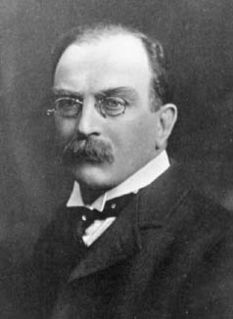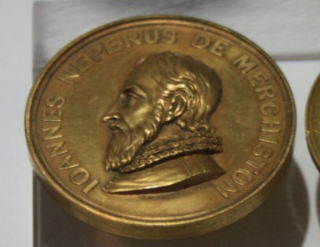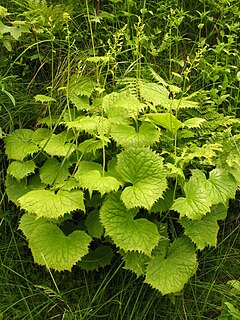
Rhododendron is a very large genus of 1,024 species of woody plants in the heath family (Ericaceae). It is either evergreen or deciduous and found mainly in Asia, although it is also widespread throughout lowland and montane forests in the Pacific Northwest, California, the Northeastern United States, and especially in the highlands of the Appalachian Mountains of North America. It is the national flower of Nepal, the state flower of Washington and West Virginia in the United States, the state flower of Nagaland in India, the provincial flower of Jiangxi in China and the state tree of Sikkim and Uttarakhand in India. Most species have brightly colored flowers which bloom from late winter through to early summer.

The Royal Society of Edinburgh is Scotland's national academy of science and letters. It is a registered charity that operates on a wholly independent and nonpartisan basis and provides public benefit throughout Scotland. It was established in 1783. As of 2021, there are around 1,800 Fellows.

Richard Anthony Salisbury, FRS was a British botanist. While he carried out valuable work in horticultural and botanical sciences, several bitter disputes caused him to be ostracised by his contemporaries.

Sir Joseph Larmor was an Irish and British physicist and mathematician who made breakthroughs in the understanding of electricity, dynamics, thermodynamics, and the electron theory of matter. His most influential work was Aether and Matter, a theoretical physics book published in 1900.

The Keith Medal was a prize awarded by the Royal Society of Edinburgh, Scotland's national academy, for a scientific paper published in the society's scientific journals, preference being given to a paper containing a discovery, either in mathematics or earth sciences.

Sir John Kirk, was a physician, naturalist, companion to explorer David Livingstone, and British administrator in Zanzibar, where he was instrumental in ending the slave trade in that country, with the aid of his political assistant, Ali bin Saleh bin Nasser Al-Shaibani.

Alexander Crum Brown FRSE FRS was a Scottish organic chemist. Alexander Crum Brown Road in Edinburgh's King's Buildings complex is named after him.
William C Carruthers was a Scottish botanist and paleobotanist.
Platanthera calceoliformis is a species of orchid endemic to north-western Yunnan province, China. It is found at altitudes of 3,200–4,000 metres (10,500–13,100 ft) in alpine grasslands. It is listed as an endangered species on the IUCN Red List.

Parasenecio is a genus of flowering plants in the groundsel tribe within the sunflower family. Most of the species are Asian, but one (P. auriculatus) occurs in the Aleutian Islands in Alaska.
Cavea is a low perennial herbaceous plant that is assigned to the daisy family. Cavea tanguensis is currently the only species assigned to this genus. It has a basal rosette of entire, slightly leathery leaves, and stems of 5–25 cm high, topped by bowl-shaped flower heads with many slender florets with long pappus and purplish corollas. The vernacular name in Chinese is 葶菊. It grows high in the mountains of China (Sichuan), Tibet, India (Sikkim), and Bhutan, and flowers in July and August.
Sir William Wright Smith FRS FRSE FLS VMH LLD was a Scottish botanist and horticulturalist.
The Botanical Society of Scotland (BSS) is the national learned society for botanists of Scotland. The Society's aims are to advance knowledge and appreciation of flowering and cryptogamic plants, algae and fungi. The Society's activities include lectures, symposia, field excursions, field projects and an annual Scottish Botanist's Conference, held jointly with the Botanical Society of Britain and Ireland for exchange of information between botanists working in different areas. Its publications include a twice-yearly newsletter, BSS News, and a scientific journal, Plant Ecology & Diversity. The society is closely linked to the Royal Botanic Garden Edinburgh and the Scottish universities.
Borthwickia is genus of flowering plants, containing one species, Borthwickia trifoliata from Yunnan, China and Myanmar. The common name in Chinese is 节蒴木. It is a shrub or small tree with evergreen trifoliate leaves, whitish flowers clustered at the tip of the branches, with many stamens, and thin, knobbly, drooping fruits with many small red seeds.
Buddleja caryopteridifoliaW.W.Sm. is a small deciduous shrub discovered by George Forrest in 1913 on open ground at 3,000 m on the Tong Shan in the Yangtze valley, China. The species was described and named by William Wright Smith in 1914.

Dr Edith Philip Smith FLS DSc FRSE was a botanist and teacher who became a fellow of the Royal Society of Edinburgh and Head of the Botany Department at Queen's College, Dundee.
James Robert Matthews FRSE FLS CBE LLD (1889–1978) was a 20th-century Scottish botanist. He was president of the British Ecological Society in 1934 and president of the Botanical Society of Edinburgh 1939 to 1942.
James Small FRSE MRIA (1889–1955) was a 20th-century British botanist and botanical author.
James Stirton was a Scottish physician and one of Scotland's leading experts on cryptogamic botany. His investigations in bryology and lichenology earned him a world-wide reputation.








